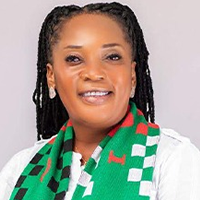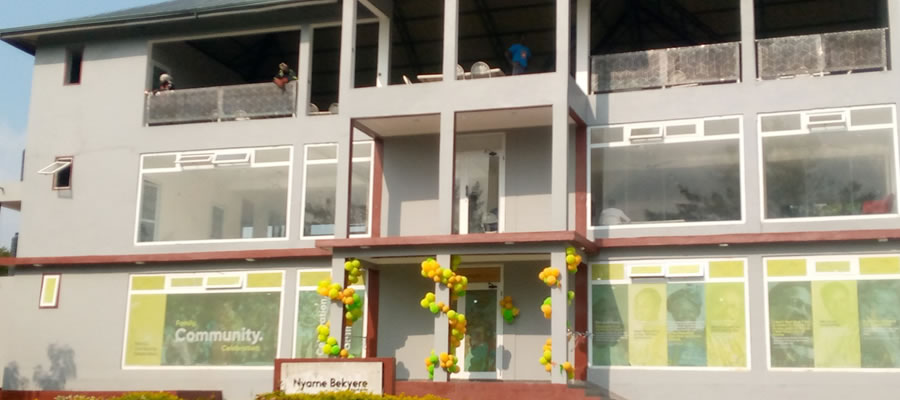
Housing Stock
The total stock of houses in the Eastern Region recorded at the 2010 Ghana Population and Housing Census was 431,697. The rural areas tend to have higher proportion of houses (64.1%) than the urban areas (35.9%). The proportion of the total regional population in urban areas from the census was 56.6 percent. This implies that a disproportionately higher percentage of the housing stock is in the rural areas. It must be noted, however, that the quality of housing in rural areas and the facilities and amenities therein are of lower quality than those of urban areas. Further analysis of the data indicates that the stock of houses increased by 52.3 percent from the 2000 housing stock of 283,461. Since the percentage increase of the total regional population was 25 percent, the gap between demand and supply of housing in the region might have narrowed during the inter censul period.
Housing Stock by District
The distribution of the housing stock by district indicates that Kwahu North District has the highest proportion of housing stock (10.1%) in the region. The Kwahu North District also has highest proportion (8.3%) of the Regional population. The Kwaebibirem District ranks second in terms of housing stock (7.4%) followed by West Akim municipal (6.9%) and East Akim municipal (6.5%) respectively. The Yilo Krobo District which has the least share (3.3%) of the regional population also has the lowest proportion (2.8%) of housing stock. The share of housing stock by district in the region closely follows that of the population distribution.
Housing Stock by Locality
There is a considerable variation in the proportion of housing stock in rural areas in the various districts, although the rural proportions are higher than those of urban areas in most districts, except for three municipalities (Birim, New Juaben and East Akim) and the Lower Manya District. The highest proportion of housing stock in rural areas was recorded in Upper Manya (90.2%) and the least in the New Juaben Municipality (9.8%).
Households per House
New Juaben South has the highest number (2.19) of households in a house compared with the lowest rate of 1.06 households per house in the Kwahu North district. The remaining districts have less than two households in a house. In the rest of the districts, the rates for the Municipalities (West Akim, Akwapem South, East Akim and Kwahu West) are higher and also approximately 2 households per house. Among the less urbanized districts, Yilo Krobo, Lower Manay and Kwaebibirem also have rates that are approximately 2 households per house.
Household Size
The population per house and household size also vary among the districts but not as much as the differentials in the other household stock characteristics. The difference in population per house is one or two, with the highest number being 8.12 in New Juaben and the lowest of 4.95 in Kwahu South.
The average household size is largest in Kwahu Afram Plains North (4.7) and lowest in New Juaben South (3.5). The number of persons per house ranges from 4.95 in Kwahu South to a high of 8.1 in New Juaben, with an average of 6.1. This average is a reduction from the 2000 level of 7.4.
Rooms in Occupied units
On the whole the single room constitutes the highest percentage (44.4%) of all the types of rooms occupied in housing units in the region. This shows a decline from the 2000 level of 48.8 percent. The higher percentage increase in household stock during the inter censal period was an increase in occupied houses with more than one room. But a substantial proportion of households with more than one person in the household sleep in single rooms. This is because when the proportion of one-person (19.9%) household is assumed to take the households with one sleeping room (44.4%), what is left is 24.5 percent and is occupied by households with two or more persons.
Number of Rooms in occupied units by District
The percentage distribution of rooms by size among the districts shows that the single and two rooms form the majority of rooms in occupied housing units. Between 60 and 75 percent of rooms in the occupied housing units in the districts are in this category. Houses with three or four rooms constitute about 10 to 15 percent of room occupancy in the districts.
Number of Rooms in Occupied Households in Urban Areas
On the average, one and two rooms are the predominant types of rooms occupied by 76 percent urban households in the region. An average of about 10 percent (10.3%) of urban households in all the districts occupies three rooms. About 6 percent (6.1%) of households occupy four rooms. Among the various districts, differences exist with regard to the number of rooms occupied by households. In the urban households, household’s occupying single rooms constitutes over 50 percent and 40 to 49 percent one-room houses in 12 districts only Asuogyaman where it occupy one room.
Number of Rooms in Occupied Households in Rural Areas
Just as in urban households, the rural households with one or two rooms constitute 42 percentages compared with hhouseholds occupying two rooms (27.0%) the region. On the average, as can be seen from Table 12. 4, the percentage of households with three and more rooms is higher for rural households than in urban areas just as the percentage with one room in rural areas (42%) is lower than that for urban areas (47%). Differences exist among the districts regarding rooms available in households in rural areas too. The percentage of households with one room ranges from 21.3 percent in Upper Manya to 55.5 percent in Birim Municipality. Larger number of rooms for households is recorded in the less urbanized districts such as Fanteakwa, Akyem Manso and Kwahu North. The pattern suggests that higher proportion of households in less urbanized districts have larger number of rooms.
Number of Sleeping Rooms available to Households
The number of rooms available to households is an indication of sleeping arrangement of household members. There are health and consequent well being implications of both for the household members. For example, some communicable diseases thrive in households where sleeping rooms are overcrowded. It is against this background that the number of sleeping rooms available to households in the Region is examined.
On the average, more than half (54.4%) of all households in the Region have one sleeping room. Only a little more than a quarter (26.6%) of all households has two sleeping rooms. A tenth also has three sleeping rooms. Those with four or more sleeping rooms constitute less than a tenth (8.7 %). Household sleeping room availability in the Region suggests that some level of overcrowding exist in the households as far as sleeping is concerned.
Number of Sleeping Rooms available to Households by District
More than half of the households in almost all the districts have one sleeping room. The lowest percentage of households with one sleeping room was recorded in Upper Manya (36.8%), followed by Fanteakwa (42.1%) and Kwahu North (43.8%). These are among the less urbanized districts in the Region. The general pattern of sleeping rooms available in the households shows that higher proportions of households in the more urbanized districts have one or two sleeping rooms. For example, 84.3 percent and 84.1 percent respectively of the households in the more urbanized Birim and New Juben Municipalities have one or two sleeping rooms compared to lower percentages in Fanteakwa (72.9%) and Kwahu North (75%) which are some of the least urbanized districts in the region.
Ownership of Occupied Dwelling Units by District
Among the Districts, even though the three types of ownership mentioned above are the predominant types, considerable differences are observed among them. The proportion of dwellings owned by a household member ranges from 30.0 percent in Lower Manya Krobo to 75.6 percent in Kwahu North. The percentage of occupied dwellings owned by other private individuals (usually a landlord) is highest in New Juaben Municipality (43.0 percent) and lowest in the predominantly rural Kwahu North District (0.4%).
Since New Juaben has a predominantly urban population, the residents are more likely to live in rented dwellings. Other Districts which have predominantly rural populations also have far lower percentages of dwellings owned by other private individuals - Akyemanso (13.7 %), Upper Manya (14.8%), Birim South (17.3%) and Fanteakwa (18.5%).
Ownership of Occupied Dwelling Units in Urban Areas
Just as in the total Regional population, the majority of urban dwellings in the Region are owned by private individual household members (39.5%), relatives who are not household members (18.8%) and other private individuals (35.5%). The far lesser percentage of occupied dwellings in urban areas owned by household members (39.5%) compared to the average (53%) for the Region is explained by the greater dependence of urban households on rented housing facility.
Thus as high as 35.3 percent of urban dwellings are owned by other private individual compared with an average of 17 percent for the Region. This pattern is observed among the Districts also. Only three out of the twenty-one Districts have more than half of the urban populations owning their dwelling- Birim South (51.1%), Fanteakwa (52.3%) and Akyemanso (57.3%). Ownership of dwellings by other private individual on the other hand exceeds 20 percent in all the Districts and reaches 50 percent in two Districts- Upper Manya (50.0%) and Suhum-Kraboa-Coaltar (49.6%).
The percentage of dwellings owned by the public/government is substantial in the urban population of some Districts. The highest is found in Asuogyaman (19.1%) where public servants working for the Volta River Authority (VRA) and Akosombo Textile Factory for instance occupy such dwelling.
Ownership of Occupied Dwelling Units in Rural Areas.
The pattern of ownership of dwelling in terms of type of ownership in rural areas is also not different from that of the urban areas. The three main types of ownership observed in the total Regional population and in the urban population are what prevail here too but the percentages differ considerably between the two types of residential areas. The difference is highest for the percentage of dwellings owned by private individual household members: 64.7 percent in rural areas compared to 39.5 percent in urban areas. The differential regarding ownership by other private individuals is also relatively high (16.7 percent in rural areas compared to 35.5 percent in urban areas). The urban-rural differentials in the proportions owned by relatives who are not household members are not large (15.7 percent in rural areas and 18.8 percent in urban areas). The rural-urban differentials in the distribution of ownership types indicate that occupation of dwellings owned by household members is more predominant among rural dwellers than in the urban areas while higher proportions of urban residents occupy dwellings owned by others who are not occupants of the dwellings. As can be observed from, occupied dwellings in all the rural areas owned by a member constitute more than two-thirds of all types of ownership in most of the Districts.
Tenure/ Holding Arrangement
Tenure arrangement of housing units is often used as a proxy indicator for the well being of households occupying the units. For example, ownership is usually an indication of affordability of housing and, to some extent, other basic needs to the household members. Perching, on the other hand, may suggest inability to own and a possibility of poverty status of households that perch with others. Renting may also lead to lack of future housing security for households that depend on renting, without saving towards building or purchasing their own, especially in urban areas where landlords may charge exorbitant rent.
The housing tenancy in the Region as recorded at the 2010 census indicates that owner occupancy, renting and perching were the commonest types of tenancy in the Region. Overall, almost all the households occupy their own housing units (46.8 percent), live in rented premises (30.7%) or in rent-free (22.1%) units. A very small percentage of households are perching (0.3%), squatering (0.1%) or have other types of tenancy arrangement (0.1%).
Tenure/Holding Arrangement by District
The three types of tenure arrangements (owner occupancy, renting and perching) were the commonest types of tenancy in all the Districts too but with some variations with respect to the proportions in the various categories. The proportion of households owning their occupied units ranges from as low as 25.3 percent in in Lower Manya to 70.9 percent in Kwahu North. The proportion of owner occupied housing units is generally lower in all the Municipalities than in the Districts with low rate of urbanization. New Juaben has the second lowest percentage (25.5%) of owner occupied housing units.
Less costly building materials in rural areas permit rural dwellers to build their own housing unit. On the contrary, costly building materials and land may prevent urban reseidents from building or purchasing their own housing. Urban residents who are migrants may also decide to invest in housing at their locality of origin while living in rented housing units at their destination. Consequently, as high as 51.9 percent of occupied units in New Juaben, the highest among the Districts, the most urbanized District in the Region is rented while 15.0 percent of this category, being the lowest, is recorded in Upper Manya, one of the least urbanized Districts. Differentials in the proportion of residents in rent-free housing facility are less than in other types of tenure arrangements.
Tenure/Holding Arrangement in Urban Areas
The pattern of tenancy arrangements observed exists in all the Districts but with differences in the percentages of occupied units having the different types of tenancy. It is only the urban population of Akyemanso that more than half (53.7%) are residing in owner occupied units. High proportions of the urban households have rented housing units; the highest being 62.4 percent in Kwahu West Municipality, followed by 57.8 percent in Upper Manya. Occupation of rent-free units also varies considerably among the urban population, with the proportion ranging from 7.4 percent in Upper Manya to 40.2 percent in Lower Manya and Kwahu South.
Tenure/Holding Arrangement in Rural Areas
The rate of ownership of of occupied units is far higher in the rural populations than urban areas of the Districts. In the predominantly rural Kwahu North District, for example, a little more than 1 out of every 4 (80.1 percent) of all the households are owner occupied. In several other Districts, over 60 percent are in this category. Again, ten other Districts have recorded between 50 and 60 percent of all units as owner occupied. The percentages of occupied units that are rent-free vary considerably in the rural areas also, with the lowest percentage of 10.6 percent in Kwahu North and 31.8 percent in Lower Manya.
Types of Dwelling by District
Compound houses constitute the majority of dwelling types in most of the districts. The percentage of dwellings that are compound houses ranges from 29.6 percent in Kwahu North to 67.3 percent in New Juaben. Just as in the entire region, separate houses and semi-detached houses respectively are second and third commonest types of dwelling in all the districts. More than half (50.8%) of dwellings in Kwahu North are separate houses and this is the largest percentage followed closely by 49.4 percent in Fanteakwa. New Juaben recorded the lowest percentage of 17.1 percent. Districts with predominately rural populations have separate houses while the more urbanized districts such as New Juaben have compound houses.
Fewer households live in flats in the region with New Juaben having the highest number of households living in flats or apartments (6.7%). The high flats and apartments occupancy rates in the New Juaben municipality could mainly be due to houses built by government and quasi government institutions. Huts or buildings on the same compound are fourth in importance. Overall, 2.8 percent of households occupy these huts or buildings on the same compound dwelling. There are variations in the distribution of huts or buildings on the same compound amongst the districts. It is most common in Kwahu North (9.6%) and least in importance in Kwahu West (0.6%) and New Juaben (0.5%). Households living in kiosks and containers constitute a small proportion of all dwelling units in the region with much smaller proportions in rural areas.
Types of Dwelling by Locality
Across the localities, differences are observed between the distribution of dwellings types occupied by urban and rural households. For the entire region, higher proportions of separate houses (71.2%), semi-detached houses (54.5%) are in rural areas. On the other hand, urban areas have higher proportion of flat/apartment (67.8%) and compound houses (55.6%). A very large percentage (88.6%) of huts is located in rural areas. For the urban and rural populations also most people live in separate houses, flats/apartments and semi-detached houses.
The urban dwellers live mostly in compound houses and separate houses while as does the rural dwellers. But a higher proportion of urban dwellers (64.8%) compared to the rural dwellers (42.2%) live in compound houses. On the other hand, a higher proportion of rural dwellers (42.7%) reside in separate houses with only about 21 percent of households in urban areas residing in separate houses.
Date Created : 10/13/2023 12:00:00 AM












 facebook
facebook
 twitter
twitter
 Youtube
Youtube
 +233 593 831 280
+233 593 831 280 0800 430 430
0800 430 430 GPS: GE-231-4383
GPS: GE-231-4383 info@ghanadistricts.com
info@ghanadistricts.com Box GP1044, Accra, Ghana
Box GP1044, Accra, Ghana